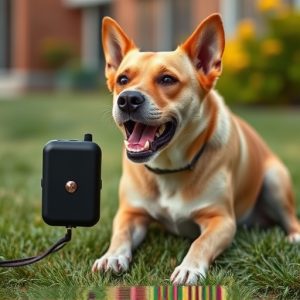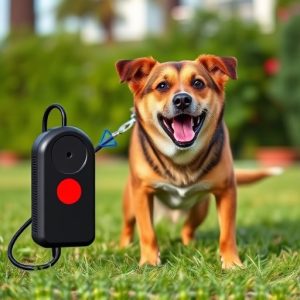Effective Dog Repellent Modes for Aggressive Pets: A Comprehensive Guide
Dog repellents address aggression triggered by territoriality, fear, or anxiety using ultrasonic sou…….
Dog repellents address aggression triggered by territoriality, fear, or anxiety using ultrasonic sound waves (40-80 kHz) and spray deterrents. Safety-focused devices prevent harm while modifying canine behavior. Customizable modes like motion-activated units cater to specific environments. Effective management combines repellent modes with training for lasting behavioral changes in aggressive pets.
“Unleash a peaceful environment with the right dog repellent! If your pet’s aggression poses a challenge, understanding their behavior and utilizing effective frequency ranges is key. From ultrasonic to sound and motion-activated repellents, this guide explores various modes tailored for aggressive dogs.
Learn how science behind these devices can mitigate unwanted behaviors. Discover essential factors when choosing a repellent and explore innovative training methods that combine repellents for comprehensive aggression management.”
- Understanding Dog Behavior: Why They Aggress and How It Affects Repellent Choice
- The Science Behind Dog Repellents: Effective Frequency Ranges Explained
- Different Modes of Dog Repellents: Ultrasonic, Sound, and Motion-Activated Options
- Selecting the Right Repellent for Your Pet: Factors to Consider
- Training and Combining Repellents: A Comprehensive Approach to Aggression Management
Understanding Dog Behavior: Why They Aggress and How It Affects Repellent Choice
Dogs can exhibit aggression for a variety of reasons, from territorial behavior to fear or anxiety. Understanding these motivations is crucial when choosing a dog repellent, as different modes of repellents cater to distinct aggressive behaviors. For example, ultrasonic dog repellents emit high-frequency sound waves that are generally inaudible to humans but irritating to canines, effective for addressing territorial aggression. On the other hand, spray repellents can be used to deter dogs that react to specific scents or visual cues, often driven by fear or anxiety.
When dealing with aggressive pets, it’s important to consider not just the immediate solution, but also long-term strategies. Training and behavior modification play a significant role in addressing underlying issues. Additionally, choosing repellents that are safe and humane is essential, as some methods can cause stress or discomfort without effectively addressing the root of the aggression. Dog repellent modes for aggressive pets should be selected based on these factors to ensure their effectiveness and well-being of both the animal and its surroundings.
The Science Behind Dog Repellents: Effective Frequency Ranges Explained
The effectiveness of dog repellents lies in their ability to emit specific frequencies that disrupt the animal’s behavior. These devices often utilize sound waves or ultrasonic tones, which are beyond human hearing but can be sensed by dogs. Different modes of dog repellents target various behaviors; for aggressive pets, high-frequency sounds can help deter attacking instincts without causing harm. The technology is designed to mimic natural predators’ vocalizations that startle dogs and encourage them to stay away from specific areas or objects.
Understanding the frequency range is crucial in choosing the right repellent. Commercial dog repellents typically operate within a range of 25-50 kHz, with some advanced models reaching up to 80 kHz. This high-frequency output ensures minimal disturbance to humans while effectively communicating with dogs. In terms of Dog Repellent Modes for Aggressive Pets, these devices offer a humane solution by taking advantage of the canine’s sensitive hearing, thereby modifying their behavior without physical restraint or punishment.
Different Modes of Dog Repellents: Ultrasonic, Sound, and Motion-Activated Options
Dog repellents have evolved beyond traditional methods, offering a range of innovative modes to cater to different needs and pet behaviors. When dealing with aggressive pets, understanding these various options is key to finding an effective solution. One prominent mode is the ultrasonic dog repellent, which uses high-frequency sound waves that are inaudible to humans but irritating to canines. This method is particularly useful for indoor settings or areas where direct noise exposure may be a concern.
Another popular choice, especially for outdoor spaces, is sound and motion-activated repellents. These devices combine the power of audio signals with sensitive motion sensors, creating an immersive deterrent. When a dog approaches, the repellent emits a high-pitched sound or even ultrasonic waves, coupled with a sudden burst of motion, effectively scaring off aggressive pets without causing harm. This mode is versatile and can be customized to specific frequency ranges known to be unpleasant for dogs.
Selecting the Right Repellent for Your Pet: Factors to Consider
When choosing a dog repellent, understanding your pet’s behavior and environment is key. For aggressive dogs, selecting the right mode becomes even more crucial. Ultrasonic repellents emit high-frequency sound waves that are typically inaudible to humans but can startle and deter canines. This option might be suitable for yard or outdoor training, but keep in mind that consistent use is often required for effectiveness.
Other modes include spray repellents, which can be effective for specific situations like car travel or during walks. Active dogs may benefit from motion-activated devices that trigger a scent or sound repellent when the pet approaches, offering a more dynamic solution. Always consider your dog’s sensitivity to different stimuli and choose a mode that aligns with their temperament for the best results in dog repellent modes for aggressive pets.
Training and Combining Repellents: A Comprehensive Approach to Aggression Management
Training and combining repellents can be a comprehensive approach to managing aggressive pet behaviors, especially in the case of dog repellents designed for modes of aggression. Different repellents may operate on various principles, such as ultrasonic sound waves or specific frequency ranges that disrupt a dog’s communication and sensory systems. By integrating multiple repellent modes, you can enhance their effectiveness and cater to different triggers. For instance, an ultrasonic dog repellent might be useful in deterring unwanted barking, while a spray repellent with a specific scent could target territorial aggression.
Consistent training alongside these methods is key. Teach your pet alternative behaviors and commands that encourage positive interactions instead of aggression. Combining repellents with training allows for a multi-faceted approach, addressing both the environmental triggers and the underlying behavioral issues, resulting in more significant and lasting changes in your pet’s behavior.
When dealing with aggressive pets, choosing the right dog repellent is a multifaceted approach. By understanding canine behavior and leveraging scientific principles behind frequency ranges, you can select from various modes like ultrasonic, sound, or motion-activated options. Considering your pet’s unique needs and combining repellents effectively can significantly enhance their usability. Remember, training plays a crucial role in managing aggression; thus, integrating repellents with positive reinforcement techniques offers a holistic solution for dog owners addressing behavioral challenges.


